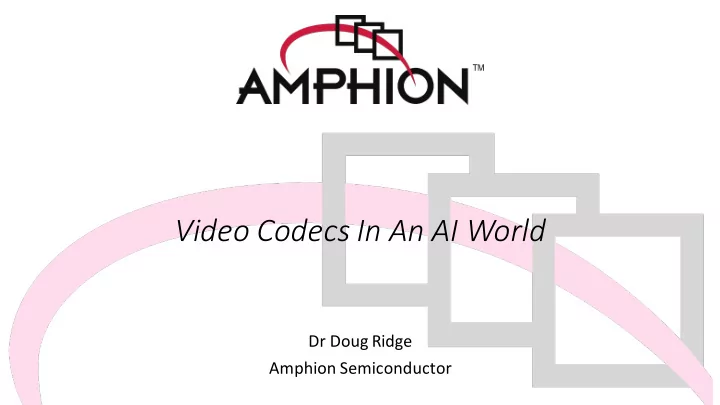

Video Codecs In An AI World Dr Doug Ridge Amphion Semiconductor
The Proliferance of Video in Networks • Video produces huge volumes of data • According to Cisco “By 2021 video will make up 82% of network traffic” • Equals 3.3 zetabytes of data annually • 3.3 x 10 21 bytes • 3.3 billion terabytes
AI Engines Overview • Example AI network types include Artificial Neural Networks, Spiking Neural Networks and Self-Organizing Feature Maps • Learning and processing are automated • Processing • AI engines designed for processing huge amounts of data quickly • High degree of parallelism • Much greater performance and significantly lower power than CPU/GPU solutions • Learning and Inference • AI ‘learns’ from masses of data presented • Data presented as Input-Desired Output or as unmarked input for self-organization • AI network can start processing once initial training takes place
Typical Applications of AI • Reduce data to be sorted manually • Example application in analysis of mammograms • 99% reduction in images send for analysis by specialist • Reduction in workload resulted in huge reduction in wrong diagnoses • Aid in decision making • Example application in traffic monitoring • Identify areas of interest in imagery to focus attention • No definitive decision made by AI engine • Perform decision making independently • Example application in security video surveillance • Alerts and alarms triggered by AI analysis of behaviours in imagery • Reduction in false alarms and more attention paid to alerts by security staff
Typical Video Surveillance System Video Decoder AI Engine Pre-Processing Image Processing Video Storage Video Encode
Video Camera Chip Considerations • Texas Instruments TMS320DM369 • 1xHDp30 (AVC only) • HiSilicon Hi3519 V101 4Kp60 • 4xHDp30 • Ambarella CV2S 4Kp30 • 8xHDp30 • Need to decode streams from supported HDp30 camera chips • Multi-format decoder necessary AVC/H.264 HEVC/H.265 • Support camera resolution and frame rate • Support multiple camera streams • AV1, VP9 support required in future
System Implementation
Multi-Stream Video Decoding • Multi-stream Operation • Time sliced between streams • Context switch at frame boundary • Negligible switch time • Firmware saves & restores hardware internal context • Single datapath decoder processes 8xHDp30 video channels in 28nm technology • Architecture needs to cater for different stream structures • Single feed consisting of multiple streams • Multiple streams from multiple sources to be processed by single decoder • Stream buffering and management necessary prior to the decoder
Video Decoder Considerations • Handling large number of concurrent streams • Typical video surveillance streams are 1080p30 • Single SoC expected to handle up to 32 streams • Single decoder instance within the SoC must decode multiple concurrent streams (typically up to 8) Minimize system cost, number of instantiations and system complexity • • Memory bandwidth challenges • Many variables impact this but could be up to ~16GBps for decode in a 32 HDp30 stream system • Additional memory for ISP/AI processing and display • Frame Buffer Compression (FBC) a possible option to reduce memory bandwidth • Real value in these SoCs is in the AI engine and associated software • Video codec IP handles standard streams so no added value by developing internally • Focus engineering effort on differentiation with AI block • Video codec IP maturity is important in reducing development risk • Low latency required where the SoC is in a control loop (e.g. ADAS)
Multi-Format Video Decoder • CS8142 ‘Malone’ Video Decoder Core CPU APB Interrupt • Supported formats Control Registers *AV1 Main Profile @L5.1 H.263 / Sorenson Spark • • Inverse Stream DivX 3.11 + GMC • • VP9 Profile 0, 2 @L5.1 Transform Pre-Parser Entropy China AVS-1 up to L6.1, • MCX Decoders H.265 HEVC MP@L5.1 Dequant Spatial • Meta Prediction AVS+ Stream De-blocking Data Merge CABAC Parser Filters H.264 AVC BP/MP/HP @L4.2 • Queue CAVLC Real Media RV8/RV9/RV10 • UVLC Huffman VC-1 SP/MP/AP • MV Motion ON2 / Google VP6 / VP8 • Prediction Compensation 32B W-Cache MPEG-2 MP/HL • BL JPEG / MJPEG • Re-Sample Filter MPEG-4.2 SP/ASP • Memory access controller • Multi stream 2D R-Cache On-chip Buffer • Up to 8 streams of HDp30 HEVC video at DTL-R DTL-W DTL-R2D DTL-W2D 28nm To Display From Decode PES/ES Decoded Demux External DDR Meta Frames Video Memory System Data Stream *AV1 Under Development (unlikely to be used in camera chips for a few years due to lack of realtime AV1 encoders)
Silicon Area and Power Consumption • ‘Brains’ and value -add of the chip is the AI engine and associated software • Deliver differentiation • Need the video encoder and decoder to be minimal size and minimal power • Allow more resources to be dedicated to the AI engine • Achieved by efficient design with an experienced team • Minimize the video codec impact on unit cost and power consumption • Processor subsystem to increase flexibility of the solution • Firmware control of top level functions • Custom functionality added through firmware • Single processor can control multiple decoders
System Level Challenges • Memory system • What happens to the data once it has been processed by the AI engine? • How to process multiple streams from multiple sources • Sharing memory to reduce system costs • Collaboration between the video codec IP vendor and the SoC designer is key • Decide on what camera chips to support before deciding on video decode engine • Support for existing chips and known planned devices • Future-proofing the design by including support for new and emerging formats
Summary • Multi-format decoder essential • Support for wide range of camera chipsets • Future-proof design by including latest and emerging formats such as VP9 • Multi-stream • Decoder needs to meet performance required for multiple streams • Memory and core architecture important in order to handle multiple streams • Efficient design • Small silicon footprint to minimize per unit cost • Low power consumption • IP maturity essential to de-risk projects
Recommend
More recommend